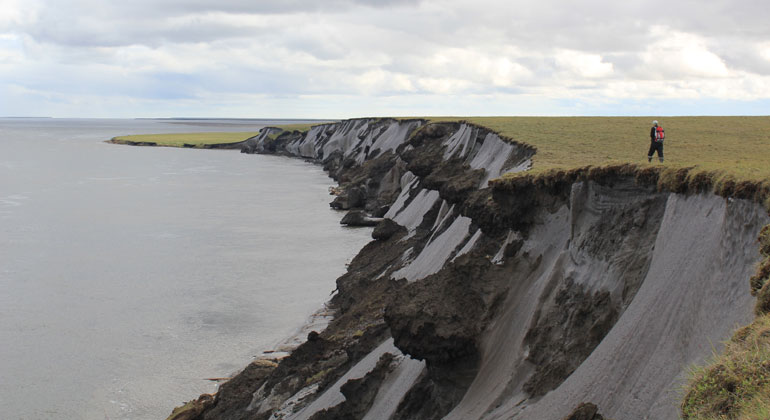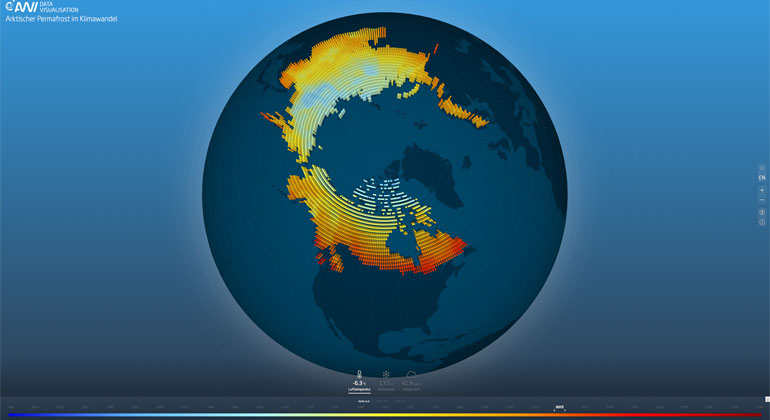Thawing Permafrost is Shaping the Global Climate
A new publication and interactive map summarise the current state of knowledge on the risks posed by permafrost soils – and call for decisive action.
How is climate change affecting the permanently frozen soils of the Arctic? What will the consequences be for the global climate, human beings, and ecosystems? And what can be done to stop it? In the journal Frontiers in Environmental Science, a team of experts led by Benjamin Abbott from Brigham Young University, USA and Jens Strauss from the Alfred Wegener Institute in Potsdam summarise the current state of knowledge on these questions. In addition, an AWI group led by Moritz Langer has now created an interactive map of the past and future of permafrost. Both publications arrive at the same conclusion: to put a stop to the dangerous trends in these regions, greenhouse-gas emissions will have to be dramatically reduced in the next several years.
Permafrost underlies no less than ten percent of the Earth’s surface. Especially in the Northern Hemisphere, there are huge expanses in which only the top few centimetres of the soil thaw in summer; the remainder stays frozen year-round, to depths of several hundred metres. At least, that’s the case so far. “Climate change represents a serious threat to these permafrost regions,” says Jens Strauss from the Alfred Wegener Institute, Helmholtz Centre for Polar and Marine Research (AWI). There, land surface temperatures have climbed two to four times as quickly as the global average. As a result, the conditions on land and in the sea are changing far faster than expected. And this can have a range of dangerous consequences – for the climate, for biodiversity and for human beings.
For example, these natural deep-freezes contain the remains of countless plants and animals, long-since dead. When the material thaws, microorganisms begin breaking it down. In the process, they convert the carbon compounds within into greenhouse gases like carbon dioxide (CO2) and methane (CH4), which can further worsen global warming.
However, predicting when and on what scale this will happen is no mean feat. “There are widely diverging views among the public,” says Strauss. For some people, the permafrost regions are a ticking climate timebomb which will soon blow up in humanity’s face. But others assume that only negligible amounts of greenhouse gases will be released in the High North in the foreseeable future.
“They’re both wrong,” stresses the Potsdam-based researcher. “Granted, there’s no reason to believe that the permafrost will suddenly start belching out huge amounts of greenhouse gases into the atmosphere a few years from now, pushing the climate past the tipping point.” Nevertheless, the situation shouldn’t be downplayed, either. “After all, today the permafrost regions are already releasing nearly the same amount of greenhouse gases as Germany’s annual emissions.” And according to scientific estimates, over the course of the next two centuries, these soils could release amounts of gas into the atmosphere that would have the same effect as several hundred billion metric tons of CO2.
In addition, as the ice and snow cover dwindle, the surface of the permafrost regions is becoming darker and darker – and is therefore warmed more by the sun than in the past, when the landscape was pure white. According to the current state of research, taken together, these two factors are among the most important influences that could change the Earth’s climate.
Loss of permafrost soils is threatening habitats – the time to act is now

The permafrost regions are also home to more than half of the Earth’s remaining wilderness. Specially adapted flora and fauna species that depend on the continuing existence of these ecosystems live there. Moreover, the thawing permafrost will mean serious problems for the millions of people living in the Arctic. The soil often becomes unstable when the ice holding it together melts. Then it suddenly collapses or is eroded by the ocean, which can end in costly damage to buildings, streets or other types of infrastructure. In the process, toxins like mercury are also released, which can be found in high concentrations in animals and people living in the Arctic.
For some communities in the High North, their entire culture and way of life depend on the frozen ecosystems. “These people have done very little to cause climate change, but they’re particularly hard hit by it,” says Strauss. Consequently, the study’s authors consider taking measures to protect the permafrost to be a question of justice.
In reality, however, the fate of the permafrost will depend on the course that political decision-makers choose for greenhouse-gas emissions in the next ten years. In light of the rapid advances made in renewable energies, the experts believe there are realistic possibilities for cutting greenhouse-gas emissions in half by 2030 and doing away with them entirely by 2050. In addition, the local population needs to be supported in protecting intact ecosystems in the permafrost regions. “There’s definitely more that we can do,” Strauss underscores. “We don’t have time for resignation.”
Interactive map shows past and future changes in the permafrost soils

Just how urgent the situation is can be seen in an interactive map developed by his colleague Moritz Langer and his team. At the AWI, Langer leads the Federal Ministry of Education and Research-funded young investigator group PermaRisk, which uses computer models to simulate changes in the permafrost and attendant risks. In this way, working with experts from the University of Oslo, the group can now offer a virtual peek into the past and future of permafrost soils.
- Information on the interactive map: https://permafrost.awi.eventfive.de
“Using the map, you can see how certain characteristics of the climate and permafrost have changed since the year 1800,” Langer explains. How warm was it on the Earth’s surface? To what depth was the soil thawed? And how much carbon was there in this active layer? Not only can these aspects be determined all the way up to the present; forecasts are also possible. On the basis of three different scenarios, the fate of the permafrost can be simulated for low, medium and high greenhouse-gas emissions. They show that, if we can succeed in keeping global warming below two degrees Celsius, a large percentage of the permafrost soil will remain stable. “Unfortunately, at the moment we’re headed for significantly higher warming,” warns Langer. And the corresponding simulation, based on warming of between 4 and 6 degrees depending on the region, paints a bleak picture: in this scenario, the great thaw will have spread to virtually every permafrost region by 2100.
- Moritz Langer, Jan Nitzbon, Brian Groenke, Lisa-Marie Assmann, Thomas Schneider von Deimling, Simone Maria Stuenzi, Sebastian Westermann: „The evolution of Arctic permafrost over the last three centuries“
- „We must stop fossil fuel emissions to protect permafrost ecosystems“ | Frontiers in Environmental Science (2022)








